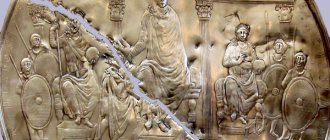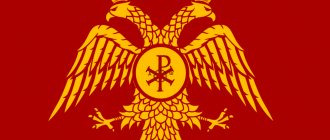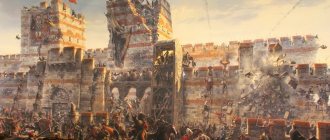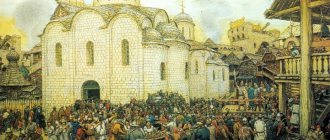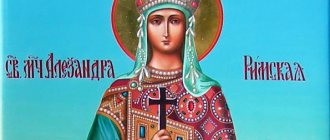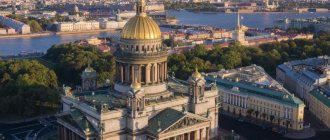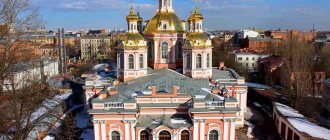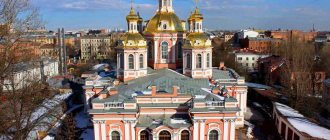If you try to find Constantinople on a modern geographical map, you will fail. The thing is that since 1930 such a city has not existed. By decision of the new government of the Turkish Republic, founded in 1923, the city of Constantinople (the former capital of the Ottoman Empire) was renamed. Its modern name is Istanbul.
Why was Constantinople called Constantinople? The amazing history of the city dates back more than one millennium. During this period, it underwent many changes, having been the capital of three empires at once: Roman, Byzantine and Ottoman. It is not surprising that he had to change names more than once. The very first name assigned to it in history is Byzantium. The modern name of Constantinople is Istanbul.
Reasons for moving the capital of the Roman Empire
Diocletian also pointed out the inconvenient position of the capital of the Roman Empire. His successors no longer chose the city of Rome as their residence. Constantine decided to move the main city of the entire state to the East. There were several reasons for this:
- The western half of the Empire was more frequently attacked by barbarians and was less well defended.
- The eastern provinces represented a more holistic cultural space.
- The eastern regions were more economically developed.
- The ancient city of the Thracians, Byzantium, had an advantageous geographical location: natural barriers reliably protected the city from barbarian invasions both from land and sea.
- Byzantium is located closer to economically developed provinces: Egypt, Syria, Asia Minor.
- From here you can easily control state borders in the Rhine-Danube direction and in the East.
- And finally, the location at the intersection of sea and land routes, at the junction of Europe and Asia, had a deep symbolic meaning.
Finished works on a similar topic
Coursework Transferring the capital of the Roman Empire to Constantinople 410 ₽ Essay Transferring the capital of the Roman Empire to Constantinople 240 ₽ Test paper Transferring the capital of the Roman Empire to Constantinople 220 ₽
Get completed work or advice from a specialist on your educational project Find out the cost
Note 1
It was to the ancient Greek city of Byzantium that Constantine, who was thinking about creating a single world empire, decided to move the capital of the Roman state.
CONSTANTINOPLE
"Panorama of Constantinople". Fragment of a miniature. 16th century University Library (Istanbul).
CONSTANTINOPLE (Κωνσταντινούπολις, in the middle-century Russian texts Tsargrad, from the Greek Βασιλεύουσα πόλις - royal city), the capital of Byzantium. Rome was founded. imp. Constantine the Great in Europe. bank of the strait Bosphorus, on the site of the ancient city of Byzantium in the fall of 324 (consecrated 11.5.330 - “birthday of the City”) as the new capital of Rome. empire (New Rome). The transfer of the capital from Rome to China was primarily due to economics. and political reasons, K.’s proximity to the rich eastern. provinces favorable military-strategic. and trading position. The territory of the city covered a vast peninsula, washed from the south by the Mramornyi metro, from the east by the Strait. Bosphorus, from the north – Golden Horn Bay. From the west, K. was protected by an extended fortress wall. The area of the city increased significantly in the beginning. 5th century, when a new triple zap was built. wall and walls along the banks. In the 7th century. The area of Vlaherna in the north was included in the perimeter of the walls. parts of K., to the south. bank of the Golden Horn, where the especially revered temple of Our Lady of Blachernae was located (c. 453; preserved source).
Defensive tower of the wall of Theodosius. 5th century
Basilica of the Studite Monastery in Constantinople. Exterior view of the apse. 5th–6th centuries
Palace of the Palaiologan era (Tekfur-serai).
Basic The structure of the city developed during the 4th–5th centuries. The center of K. was sq. Augusteon, around which the Great Imp was located. the palace (the main entrance to it is the Halka Gate), the Hagia Sophia temple, the hippodrome (partially preserved) and the Baths of Zeuxippus (a city museum where artistic monuments were brought from all over the Roman Empire). To the north of the center, on the territory of the former Byzantium, there was the Capitol, where until the end. 4th century pagan temples were preserved. Ch. led to the west from the center. street - Mesa, decorated with porticoes on both sides and connecting several successively. mountains squares: the forum of Constantine (round in plan; the column of Constantine, which was in the center, remains preserved), the forum of Theodosius (square in plan, with a triumphal arch and the basilica of Theodosius), as well as the forums of the Bull and Arcadia. From the forum Feodosia st. The mesa forked, and one of its branches went further to the west, to the Golden Gate [preserved; see Topkapi; start of strategic Rome. the Via Egnatia road to the city of Dyrrachium (now Durres) - a port in the west of the Balkan Peninsula]; the second - to the north-west, to the Adrianople Gate (preserved; now Edirnekapi; the beginning of the road to Serdika and Sirmium). From the mountain springs of the Vize region (in Thrace), an aqueduct was stretched more than 100 km to the water tanks in the center of Cyprus (known as the Valens Aqueduct, built ca. 370, partially preserved).
Outside the walls of K. were: Evdom (military camp, west of the city), Pigi (mon. Life-Giving Spring, west of the city; partially preserved), Galata (Siki; settlement on the northern bank of the Golden Horn), Chrysopolis (a city on the eastern bank of the Bosphorus; now the district of Istanbul - Uskudar), Chalcedon (a city on the eastern shore of the Bosphorus, south of Chrysopolis; now the district of Istanbul - Kadikoy), Princes' Islands (the center of Byzantine monasticism).
With the increase in barbarian attacks on the Balkans from the horse. 4th century K. turned out to be vulnerable from land, from Thrace. The Byzantines took measures to strengthen the city and the approaches to it. Under the emperors Arcadia and Theodosius II in the 5th century. new mountains were built. walls (preserved); in the beginning. 6th century at imp. Anastasia I erected a Long Wall 65 km from K., 45 km long, designed to protect the immediate surroundings of K. from the west (abandoned in the 7th century due to lack of funds for its repair and defense; partially preserved). In the 4th–6th centuries. K. developed rapidly. According to the notice, approx. 425 K. was divided into 14 districts; it had 5 palaces, 14 temples, 4 forums, 4 mor. port, 4388 households. In the 1st half. 6th century K.'s population reached approx. 500 thousand people In the 5th–7th centuries. a typical feature of mountains. life became the party of the hippodrome - Dima. By uniting tens of thousands of fans. teams of riders and charioteers, they turned into large political parties. forces with which the emperors were forced to reckon.
"The Virgin Mary and Child enthroned by the upcoming emperors Constantine the Great and Justinian I." Mosaic of Hagia Sophia.2nd floor. 10th century
From the beginning of its history, China developed as the largest center of Christianity. Constantine the Great, in addition to the Church of St. Sophia, probably founded the Church of St. Irene (north of the Church of St. Sophia), as well as the churches of St. Akakios at the Golden Horn and St. Mokios (in the cemetery outside the city wall, on the western outskirts TO.). All R. 4th century, under imp. Constantius II, next to the mausoleum of Constantine in the north. In part of K., the Cathedral of the Holy Apostles was built, which served as the tomb of the Byzantines. emperors until the 11th century. In the 5th century the first mountains appeared. monasteries (including the Studite Monastery, created around 453; partially preserved). In the 1st half. 6th century An extensive church building program was carried out. During the reign of the Emperor. Under Justinian I, the following churches were rebuilt: St. Sophia (532–537; preserved), Holy Apostles (536–549), St. Irene (c. 527–536; preserved); also erected c. St. Polyeuctus (524–527), St. Sergius and Bacchus Church (c. 527–536).
The decline of K. began after a severe plague epidemic in 541–542, which killed perhaps up to half of the city's population. Builds. activities in K. continued until the end. 6th century After the conquest of Egypt by the Persians (619), the import of grain into Egypt ceased, and the free distribution of bread was abolished. In 626, K. survived the siege of the Avars, Slavs and Persians, who ravaged the suburbs and destroyed the mountains. aqueduct. Economical and K.'s cultural ties with the Middle Eastern regions of the empire began to weaken after the Arab. conquests of the 7th century Byzantium lost part of its territories in the East. In 674–678 the city survived the blockade of the Arabs. fleet, which temporarily seized control of Marmara, in 717–718 - the siege of the Arabs. land army. In the 8th century. K.'s population did not exceed several tens of thousands of people.
Economical K.'s rise began in the 2nd half. 9th century (earlier than in the provinces). However, in the 9th–10th centuries. mountains construction remained limited. All R. 9th century imp. Basil I the Macedonian undertook the repair of a number of temples, and also in 880 erected the 5-domed Nea Ekklesia temple next to the Great Palace, which became one of the examples of Eastern Christian cross-domed temple architecture. Minor reconstructions were constantly carried out inside the Grand Palace complex. Builds. activity of imp. the Lekapin family (1st half of the 10th century) is associated with the palace and temple of Mireleyon (c. 920; Bodrum Jami).
The location on the Bosphorus allowed K. in the 11th–12th centuries. control the entire pestilence. trade in the Black Sea basin and contributed to the transformation of the city into the largest market for the exchange of goods between the West. Europe, Caucasus, North. The Black Sea region and the Middle East. Development of international connections led to the emergence of several foreign countries along the shores of the Golden Horn. trading posts (mainly Italian). Means. construction was mainly concentrated in the hands of the emperor. families and large magnates who, seeking to support the Church, created new monasteries and temples: the Virgin Mary Perivelept (founded in the 1030s by Emperor Romanos III Argir), Mangana (founded in 1043 by Emperor Constantine IX Monomakh), c. Christ the All-Seeing (Pantepopta, 1081–87; Eski-Imaret-jami); mon. Christ Pantocrator Pantocrator (founded in 1133 by Emperor John II Komnenos; Zeyrek-Kilise-jami), etc.
Several large fires in 1203 and the destruction of K. by the crusaders in 1204, during the 4th Crusade, led to the destruction of most of the cultural property stored in the city. In 1204–61, K. became the capital of the Latin Empire, economic. dominance in it passed to the Venetians. The crusaders used some of the temples, monasteries and buildings for their own needs, but many fell into disrepair or were completely abandoned. The liberation of K. in 1261 by the Byzantines did not lead to the revival of the city. Byzantine. the empire of the Palaiologan dynasty (1261–1453) already had very limited resources for the development of its capital; in K. there remained vast wastelands, many. buildings and entire areas were used as quarries. The Grand Palace in the old center of K. was finally abandoned, and ch. imp. the residence now served as the palace in Blachernae (one of the palaces of the Palaiologan era, Tekfur Serai, has been preserved). Simultaneously with the decline of K., the Galata region, where the largest trading post of Genoese merchants was located, was rapidly developing. Palaiologi and Byzantium. know con. 13th–15th centuries continued to support a number of temples and monasteries, such as Hora (Kahrie-jami), Lipsa (preserved; one of the tombs of the Palaiologos; Fenari Isa-jami), Our Lady of Pammakarista (Fethiye-jami). From the end 14th century The Ottoman Turks made more than once attempts to take possession of K. After a long siege, the city was taken by the Turks on May 29, 1453 and became the capital of the Ottoman Empire. At the time of the capture of K. by the Turks in 1453, the population of the city was approx. 50 thousand people For further history of the city, see Art. Istanbul.
Transfer of the capital from Rome to Constantinople
On November 8, 324, Constantine ordered the construction of the site for the new capital of the state to begin. According to legend, he himself outlined the location of the future center of the world with a spear. Since that time, the borders of the ancient city of Byzantium have been expanded, luxurious buildings have been built, symbolizing the power of the Roman emperor: baths, palaces, a stadium, a library, a hippodrome.
On May 11, 330, the city was inaugurated and the Second Rome was declared the capital of the Roman Empire. New Rome was consecrated according to pagan and Christian customs. Constantine named the new capital after himself - Constantinople. At the celebration, the emperor was revered as the god Helios, and Constantinople was placed under the protection of the goddess Tyukhe (goddess of luck and fate).
Are you an expert in this subject area? We invite you to become the author of the Directory Working Conditions
Numerous works of art were brought from Rome and Greece to decorate the new capital. They were used to decorate streets, squares and buildings.
Emperor Constantine modeled the administration of the city on the model of the administration of Rome. The city government was headed by the city perfect (mayor). A senate with special powers was created from the senators who moved from Rome. The plebs of Constantinople received the same rights as the Roman plebeians.
Constantine used the new location of the capital to strengthen his own power. The new city was not loaded with the ancient traditions of old Rome, which contributed to the strengthening of dominance.
Konstantin spent the rest of his life in his city or in its environs. Shortly before his death, the emperor received baptism and became a Christian. He was baptized by Bishop Eusebius, who supported the views of Arianism. Constantine died in 337, after which he was deified.
Why did Rus' choose Christianity?
The Kiev prince Vladimir (Vladimir the Baptist or Vladimir the Red Sun), having decided to move away from paganism and not trusting local preachers, sent ten ambassadors (who stood out among the boyars for their prudence) to distant countries. So he wanted to find out the essence of the faith of other peoples before deciding which path Rus' would take in its religious views.
Attending a service in the magnificent St. Sophia Church so shocked the Russian delegation that upon returning to Kyiv they enthusiastically described to Vladimir the beauty and splendor of Greek rituals.
At the end of their report, they reminded the prince that his grandmother, Grand Duchess Olga (whom Vladimir revered very much), had not converted to Christianity in vain: everyone knew how wise this woman was. The last argument convinced the prince of the need to convert to the Christian faith.
The exact date of Prince Vladimir's baptism is not known. The Tale of Bygone Years claims that this happened in 988. Soon after his baptism, the prince married the Greek princess Anna, the sister of the Byzantine rulers Vasily II and Constantine VIII.
Returning to Kyiv (Greek Metropolitan Michael came with him from Byzantium), Vladimir baptized his children and all the inhabitants of Kyiv. The place of mass baptism of townspeople is still called “Khreshchatyk”.
The significance of moving the capital to the East
Old Rome retained special privileges and a special status for a long time. But only Constantinople was recognized as the capital. This circumstance spoke of the continuity of state power. But at the same time, it pointed to the competitiveness of the new capital, which is a symbol of the triumph of Christianity over paganism and the spirit of new historical realities. The rivalry between Rome and Constantinople demonstrated the struggle between West and East, which ended in the division of the Roman state.
Note 2
The founding of New Rome is the moment of the birth of the new Byzantine power. Some historians are inclined to see this as the beginning of a new era in the development of mankind - the Middle Ages.
Do you need to select scientific articles for your academic work? Specify a topic and receive a response in 15 minutes get help
